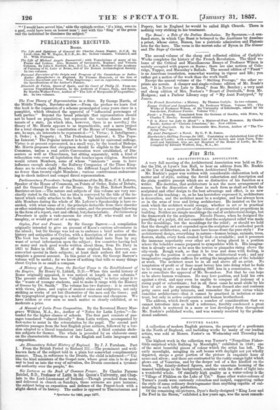/in Irt5,
THE ARCHITECTURAL ASSOCIATION.
A very full meeting of the Architectural Association was held on Friday the 23d, at Lyon's Inn Hall, to hear an address from Mr. Ruskin on the Use of Imagination in Modern Architectural Design.
Mr. Ruskin's paper was written with considerable elaboration both of matter and of style, uniting the fervid exhortation and description and the plain positive precept which are so distinctive of his function as a writer. His doctrine, that architecture is not the mere arrangement of masses, but the disposition of these in such form as shall set forth the sculptural and other design to the best advantage and effect, is no new feature of his teaching ; or, as he has heretofore expressed it, architecture is decoration, and the architect must be a sculptor, and has always been so in the tents of true and living architecture. He insisted on the low rank which the architect would occupy, whether in art or in practical use, were he a mere professor of the science of geometrical proportions in building. Neither are simple mouldings the end of architectural design, but the framework for the sculpture. Niccolo Pisan°, when he designed the panelling of a pulpit, did not consider that the sculptured relief was made for the mouldings, but the mouldings for the relief; or should we hold that the thought and art expended upon the sculpture of a cathedral porch are impure architecture, and a mere bare house-front the pure style ? For architectural design, everything in nature—human beings, animals, trees, flowers, shells, every form created by God—is available ; and it possesses the immense superiority over other art of being placed in a position where the beholder comes prepared to sympathize with it. His imagination is already active as he sees the towers or pinnacles rising above the city-roofs. Rough work, so that it be true and done with feeling, is enough for the position it occupies in the architectural work ; and any imaginative suggestion suffices for setting the imagination of the beholder at work. The architect must be in all and above all an artist. No temptation of profit or of fame must betray him into doing what he feels to be wrong in art ; no fear of making 5001. less in a commission, or desire to conciliate the approval of Mr. So-and-so. Not that he can hope to be above human weakness. He may love position, and hold his own against a rival, and may even be unable to conquer all jealousy of a rising pupil or subordinate ; but in all these cases he must abide by his love of art as the supreme thing. He must discard also and contemn petty cares and petty interests, and remember the great virtue which ennobles architecture—that it cannot be practised in isolation or mistrust, but only in active cooperation and human brotherhood.
The address, which dwelt upon a number of considerations that we cannot introduce into so brief a reference, forcibly condensed a great deal which is scattered in a more or less developed form throughout Mr. Ruskin's published works, and was warmly received by the professional audience.













































 Previous page
Previous page